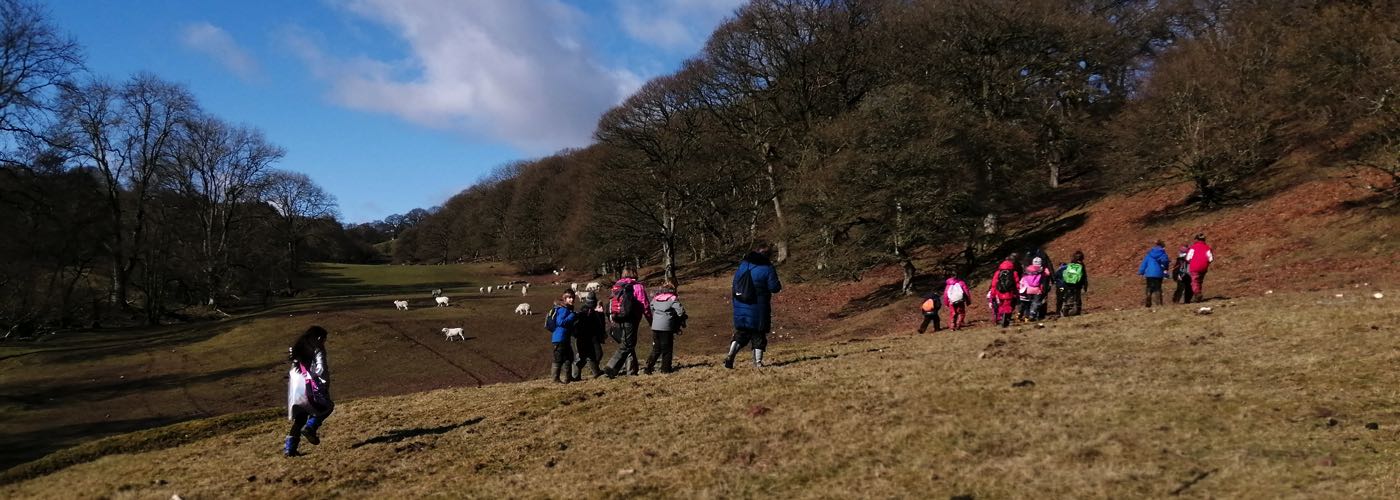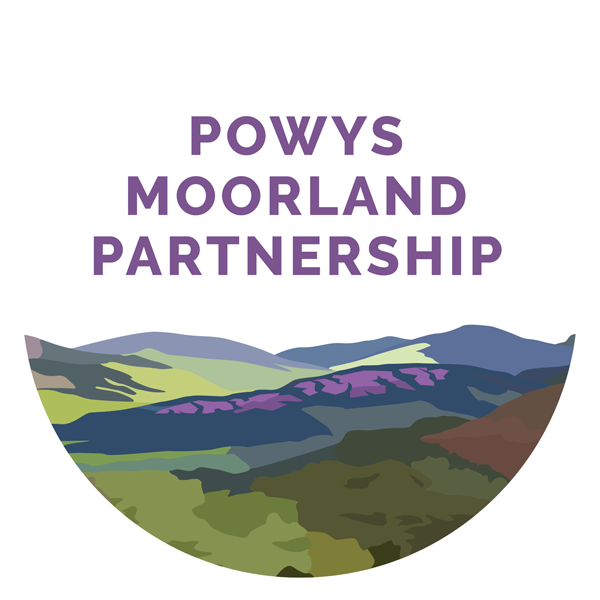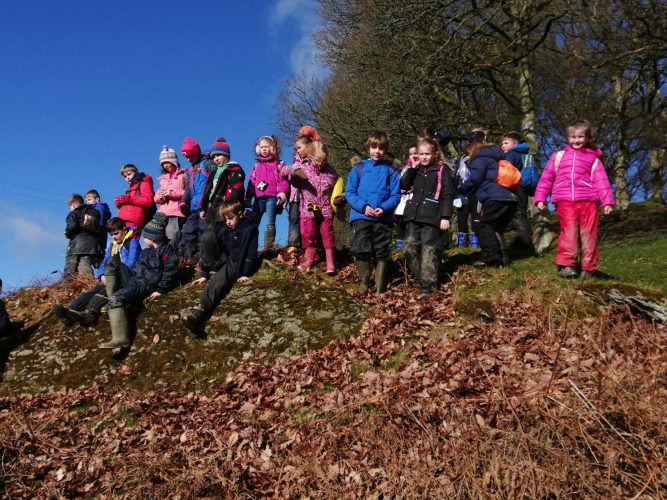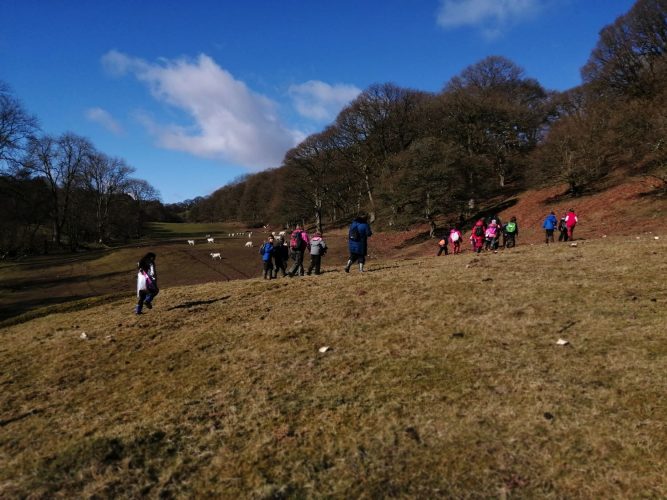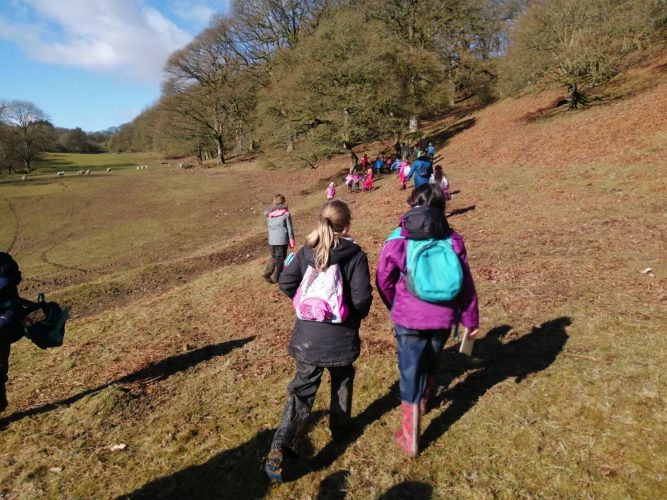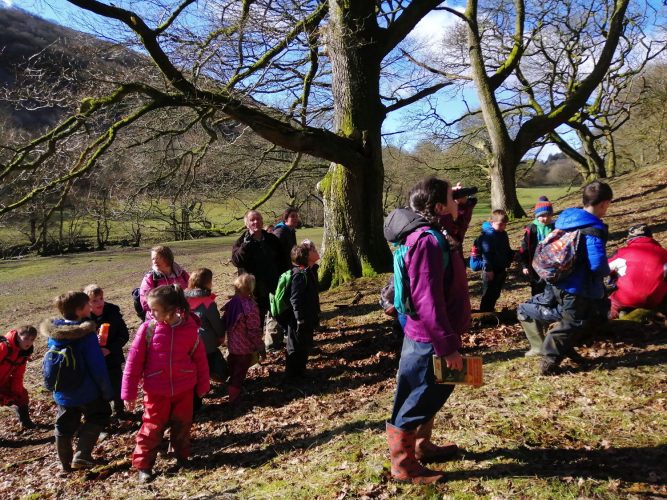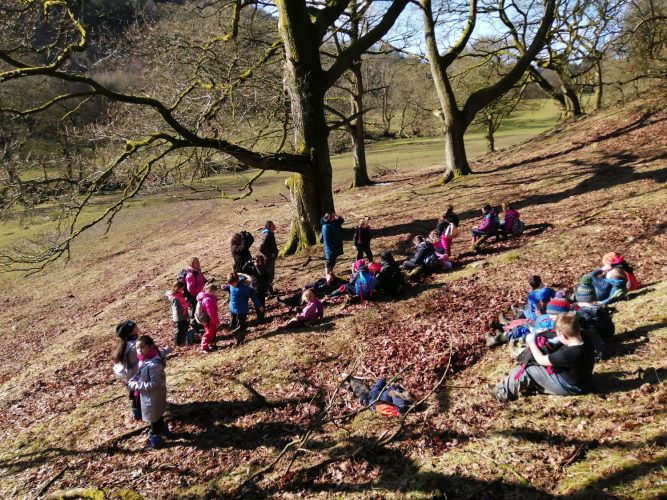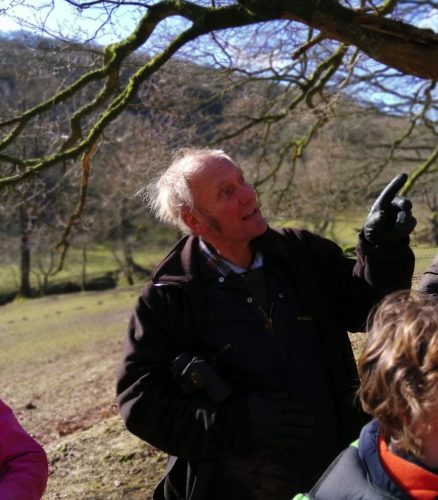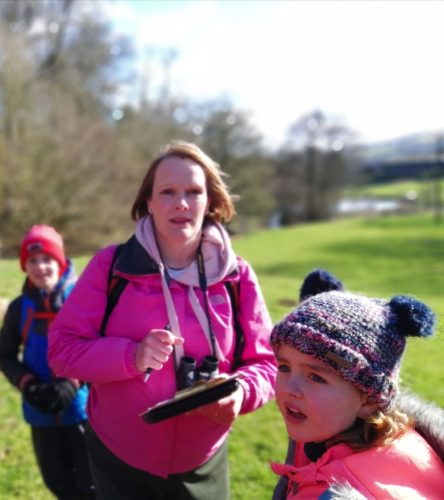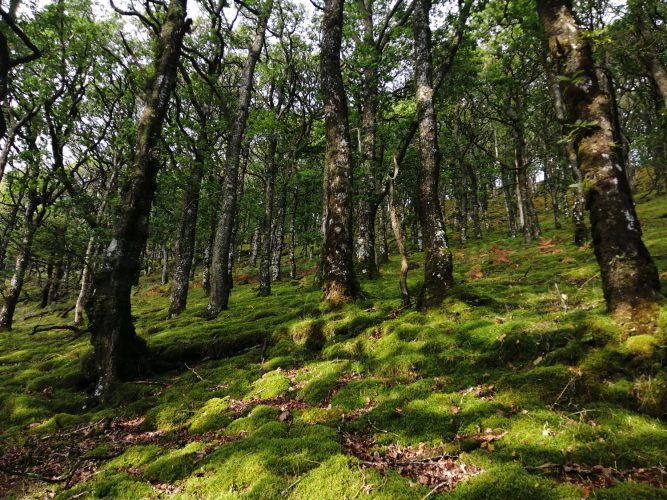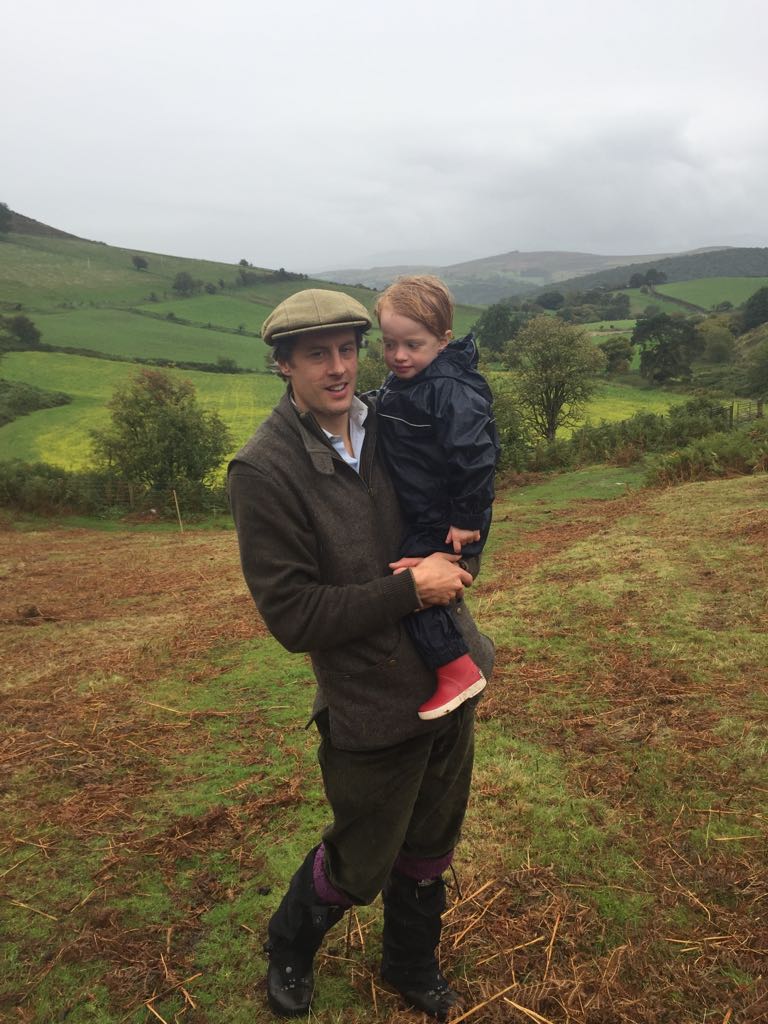It’s a very simple task but the excitement by Clyro school children who visited a farm last month (27th Feb) demonstrates the power of just getting outside & embracing nature by doing a bit of bird watching.
Part of the Big Farmland Bird Count #bfbc held on 100s of farms across the UK last month, the aim for the children was to see & record what birds are surviving the winter when all the seeds and berries have gone.
Twenty seven children from across key stage two at Clyro Primary School were fully equipped with waterproofs, wellies and bird books to see what birds they could hear and see with the help of Nick Myhill from the Powys Moorland Partnership project which sponsored the event.
The citizen science programme aims to get more people involved in seeing what birds are responding to what measures on farms that can help birds survive the ‘hungry gap’ months.
Kate and Gwyn Lewis at Llanbedr Hall near Painscastle kindly hosted the event and welcomed the children. They run a mixed farm where there are a number of connecting habitats, from hedges and trees, streams, ponds and woodlands where many bird species were noted.
Nick Myhill drew attention to the different sounds of birds particularly the Song Thrush which has many different melodies which makes them tricky to pinpoint.
Along with Red Kites and Buzzards that moved along the farm with the children they identified Blue Tits, Great Tits, Long Tailed Tits, Blackbirds, Bullfinch, Carrion Crow, Chaffinches, a Great spotted woodpecker, House Sparrow, a Magpie, Mistle Thrush, Mallards, Ravens, Robins, Song Thrush, a Sparrowhawk, Starling, Stock Dove, Woodpigeon and a Wren.
“We have got to engage more with the public so that they can see for themselves what our countryside has to offer,” says Kate, who believes that we have got to get the positive messages out on how wildlife and farming are so important to each other and how it all interconnects. “There’s nothing that beats seeing it for yourself,” she says.
Mrs Phillips is the teacher at Clyro school who has instrumented these farmer and moorland events over the PMP project period. “We always jump at the chance to get outside and meet the farmers and hear it from them as to what is happening in our amazing landscapes. It also gets the children involved in nature which we take back to the classroom for future research. It really gives them something positive to think about and challenges them regarding where our food comes from and its crucial link with wildlife.
“It’s always a great day for us to be outside and despite the weather the children are so motivated by something so simple as bird counting.”
Catherine Hughes, the PMP project facilitator comments: “These children have been out a number of times to look at different aspects of the landscapes. From curlew watching last spring, to walking the length of the moorland at Llanbedr hill to take part in the tales of the Mabinogion, we are creating a picture of the importance of our landscapes which is so valuable.”
Making the connections of where we live is what the PMP has been demonstrating over its 3 years. We believe that school visits really do address the Five Ways to Wellbeing, which are
- Connect – with the people around you, with family, friends, colleagues and neighbours, at home, work, school or in your local community. …
- Be active – exercising makes you feel good. …
- Take notice – be curious. …
- Keep learning – try something new. …
- Give – do something nice for a friend, or a stranger.
Sustainable farming and land consultation with farmers
The Powys Moorland Partnership is currently interviewing farmers in and around the project area to feed into the Sustainable farming and our land consultation.
It’s difficult to know how many more trees can be planted and how wildlife corridors can be improved in much of the Radnorshire uplands. The place is already rich in habitats, wildlife, carbon stored in the trees, hedges and soils. Their landscape has changed very little and being well over 1000 feet above sea level taking out hedges and trees was not a consideration. It’s windy up here and you can see what they mean with the shape of individual windswept trees that have been sculpted by the sometimes brutal climate. The trees have protected us, our farms, our wildlife and our livestock, they say. Every farm is individual and needs a different approach. Each has its own outcomes to deliver but it must be the farmer to decide what those are. The call from the farmers is a desperate “please listen to us first, we haven’t just arrived here and finding out what’s what, we have been here for generations and that knowledge has been passed onto us. We think that’s important. We hope you do too.”
Although they recognise the new payments could be scary – because nobody knows yet what they look like – the vast majority have their sleeves rolled up and are ready to embrace the new challenges. Call them wildlife farmers, carbon farmers, whatever farmers, as long as there is a sensible scheme in place that is properly funded and supported by people who know what they are talking about, I get a sense that these farmers are not about to abandon the land, which is a good job because there’s no one else up there who can do what they do.
One farmer told me how his dad would always spend hours clearing the roads in the snow for everyone around here or clearing debris when there was heavy rainfall because the council couldn’t get anywhere near, but today there is usually only one person left working on a farm who doesn’t have enough time and which was what kept rural communities together. The countryside needs more people, not less, and these people feel that wildlife needs them with their grazing stock more than ever.
Curlews protection on BBC4 Farming Today
On 25th June, BBC4 Farming Today‘s show about Controlling Mountain Hares in Scotland, Fenland farm report and Curlews featured a whole section about Curlew conservation in Wales and an interview of our very own Nick Myhill, farmer and conservation expert, working with Powys Moorland Partnership amongst other initiatives to protect the curlews through a range of actions, from habitat improvement to predator control. Listen to the show below.
The curlew’s population has dropped by 80% over the last 30 years with only about 50 000 pairs left nesting, among which 300 or 400 hundreds are located in Wales. RSPB Cymru suggests that farmer practices might be partly to blame. Nick Myhill explains that the modern agricultural practices are partly responsible for different reasons, but they’re not the only reason for that drop in numbers. A hundred years ago, the curlews would stay on the Moor where it lived the rest of the year to nest. Since then, potentially to escape predators or the public, they have started to move to hay fields. Modern agriculture has replaced hay-making by sillage, which is a much faster process that happens earlier in the year. The curlew needs effectively two months of peace in a mowing field, the four first weeks to incubate and the five after that for the chicks to be able to move around on the ground.
Huw Jones is one of the local farmers involved in the program to protect the curlews. His advice is for people to work together and be aware of the curlews, avoiding any topping and mowing while the birds nest in the fields. Huw also suggests that the structuring of farming could be partly responsible because costs of production have been going up so that farming entreprises might not have been as proactive as they used to be. But there is hope, if people are looking to be more sensible and work together.
Header photo by Jason Thompson.
Breeding season – time for reminders!
The PMP is putting a leaflet together with our key collaborators, the farmers, graziers, BHS, Ramblers, Powys CC etc. so that we help people use our landscapes responsibly especially as we approach the breeding season. Dog walkers are reminded that keeping dogs under close controls and sticking to the paths is critical at this time of the year if we are maximise our breeding successes. This applies to birds and lambs who need all the protection they can get this spring.
Maureen Lloyd – secretary of the graziers and one of the gamekeepers Huw Lavin will provide their contact details on the leaflet so that people can have a contact while out on the moor.
The economics of the Powys moorlands
The topic of what the British uplands should look like in 100 years time is much discussed and everyone has a view.
The visible threat to our existence posed by climate change when combined with some fundamental changes to the subsidy system post Brexit means that policy makers are very focused on what landscapes can do for the greatest possible good. This creates inevitable tensions from a vocal constituency promoting ‘rewilding’ who seek to end many of the ‘traditional’ uses of moorland landscapes.
In the case of the Powys moors, can farming and recreation compliment the ability for these hills to process rainfall, store carbon, clean the air and host globally rare habitats and bird species? In short, is the way these moors are managed making the most of what this natural environment can do for society? Public money will only go towards public goods in the widest possible sense.
We believe that with the right resources and focus, a sensible balance can be struck. The catch, of course, is that new funding is required to achieve this outcome. This is because nothing is free and the current Government funding ends in 2020.
The PMP tasked the experts, Economics For The Environment (EFTEC), to compare the total value of public goods performed by the Powys moors with what they cost to maintain over a 25 year period.
The benefits that provide actual revenues (money from food production and shooting) are far less than the ongoing management costs that sustain these services. But, since the sum total of all these public goods is a large number – it would cost society £13m or £500k annually to secure equivalent benefits if the moors were not there – it’s surely worth securing these benefits and also increasing them.
As custodians of the Powys moors we strongly advocate the need for full time moorland keepers to work with the graziers to prevent wildfires, promote biodiversity and prevent any more loss of rare heather habitat. Visitors come for the great views but the management that we fund gives these lands their uniqueness with heather and rare species more viewable here than almost anywhere else in Wales.
But, to bring your horse, dog, friend, motorbike, 4×4 to this ground is free. Managing the landscape to make it last, mitigate climate change and produce public goods is not free. There is a large gap here. By valuing its Natural Capital the PMP hopes to add some facts and figures to inform future public policy and to slowly narrow the funding gap to sustain the ongoing love that these lands deserve.
Preserving our semi-feral Welsh ponies
With no stallion on the hill for almost eight years, and some of the mares – out grazing all year – are now in their 20s. The owners of these wonderful ponies selected a few of them to put into foal in 2018. Registered with the Welsh Pony & Cob Society, these semi-feral section A mares come from Pendre (Pendre Farm), Painscastle (Newhouse Farm) and Llewetrog (Llewetrog Farm) and are monitored by the Llandeilo Graban Hill Pony Improvement Society.
“This predominately closed herd is in desperate need for youngstock to carry on the bloodlines which go back generations,” says Lisa Lloyd, whose family has a long association with the ponies at Pendre.
”They are an intrinsic part of the landscape, culture and heritage and are irreplaceable,” says Lisa, who explained that at the last gathering in May 2018 they selected 13 mares and put them – funded partly by the PMP – to a leased palomino section A stallion, Afon Carousel (Criccieth Arwr x Afan Caroline) from the Afan Stud, Llanafan, to run with the mares for six weeks.
Photo kindly taken by Kerry Hendry
Colin Thomas is vice chairman of the WPCS and has worked in an advisory capacity with the breeders who graze Ireland Moor, which according to him ‘is one of the most picturesque landscape in Wales’. He is delighted that we can expect some foals this spring. He comments:
“These semi-feral equines found in the hills and valleys of Wales are descendants from the ancient celtic horses which have made a huge contribution to the cultural landscape of Wales through the millennia, encapsulated today by the continued effort of breeders who against considerable odds have maintained this most iconic of the Welsh breeds.”
“The hills of Wales and the borders were alive with hill pony herds of wild, hardy animals left virtually to fend for themselves, ensuring that only the hardiest survived. Nature’s doctrine of ‘survival of the fittest’ led to the natural selection of the Welsh Mountain pony; alert, robust, adaptable, durable, clever and graced with beauty.
“The hills and mountains of Wales contain some of the most attractive countryside in the world and have evolved and shaped that way because of generations of pony breeders and farmers.”
“Over many generations their fortunes have ebbed and flowed in tune with the economic and environmental dynamics of the time, but it is a testament to their tenacity and fortitude that in spite of a whole variety of negative pressures, pony breeding has still survived. The WPCS still promotes and provides premium grants on an annual basis for hill stallions and foals.”
“It is essential that these ponies breed on this area to preserve and maintain the gene pool. Their contribution to conservation, habitats and wildlife is well noted by senior ecologists and is also vital to this unique way of life. “I sincerely hope that breeding ponies on their natural environment will continue and flourish,” concludes Colin.
Walter Price – Memories of farm life, sheep, curlews, canny cows… and pubs
Walter Price was bought up on a small holding on Ireland Moor. Walter’s father Ben was head head gamekeeper on Ireland for many years. Recorded in conversation with Catherine Hughes, 2017, when Walter was 94 years old.
Interviewer – Catherine Hughes
Music Soundtrack & Introduction – Jeremy Creighton Herbert
Sound Recordist – Jeremy Creighton Herbert
Keep in touch, get involved.
We will be putting on various events over the next 12 months. If you would like to get involved, have some ideas please contact Catherine on urmyc.sdnalroomsywop@tcatnoc
